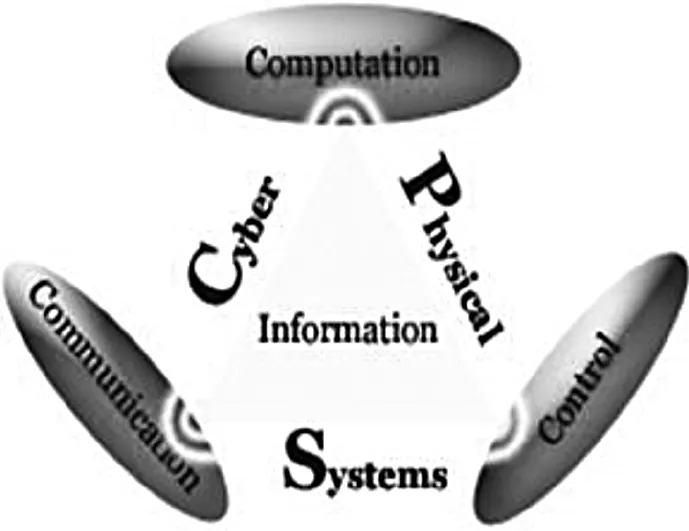
eBook - ePub
The Internet of Things in the Cloud
A Middleware Perspective
Honbo Zhou
This is a test
Partager le livre
- 391 pages
- English
- ePUB (adapté aux mobiles)
- Disponible sur iOS et Android
eBook - ePub
The Internet of Things in the Cloud
A Middleware Perspective
Honbo Zhou
Détails du livre
Aperçu du livre
Table des matières
Citations
À propos de ce livre
Although the Internet of Things (IoT) is a vast and dynamic territory that is evolving rapidly, there has been a need for a book that offers a holistic view of the technologies and applications of the entire IoT spectrum. Filling this void, The Internet of Things in the Cloud: A Middleware Perspective provides a comprehensive introduction to the Io
Foire aux questions
Comment puis-je résilier mon abonnement ?
Il vous suffit de vous rendre dans la section compte dans paramètres et de cliquer sur « Résilier l’abonnement ». C’est aussi simple que cela ! Une fois que vous aurez résilié votre abonnement, il restera actif pour le reste de la période pour laquelle vous avez payé. Découvrez-en plus ici.
Puis-je / comment puis-je télécharger des livres ?
Pour le moment, tous nos livres en format ePub adaptés aux mobiles peuvent être téléchargés via l’application. La plupart de nos PDF sont également disponibles en téléchargement et les autres seront téléchargeables très prochainement. Découvrez-en plus ici.
Quelle est la différence entre les formules tarifaires ?
Les deux abonnements vous donnent un accès complet à la bibliothèque et à toutes les fonctionnalités de Perlego. Les seules différences sont les tarifs ainsi que la période d’abonnement : avec l’abonnement annuel, vous économiserez environ 30 % par rapport à 12 mois d’abonnement mensuel.
Qu’est-ce que Perlego ?
Nous sommes un service d’abonnement à des ouvrages universitaires en ligne, où vous pouvez accéder à toute une bibliothèque pour un prix inférieur à celui d’un seul livre par mois. Avec plus d’un million de livres sur plus de 1 000 sujets, nous avons ce qu’il vous faut ! Découvrez-en plus ici.
Prenez-vous en charge la synthèse vocale ?
Recherchez le symbole Écouter sur votre prochain livre pour voir si vous pouvez l’écouter. L’outil Écouter lit le texte à haute voix pour vous, en surlignant le passage qui est en cours de lecture. Vous pouvez le mettre sur pause, l’accélérer ou le ralentir. Découvrez-en plus ici.
Est-ce que The Internet of Things in the Cloud est un PDF/ePUB en ligne ?
Oui, vous pouvez accéder à The Internet of Things in the Cloud par Honbo Zhou en format PDF et/ou ePUB ainsi qu’à d’autres livres populaires dans Informatique et Technologies de l'information. Nous disposons de plus d’un million d’ouvrages à découvrir dans notre catalogue.
Informations
I
The Internet of Things
Chapter 1
The Third ICT Wave
1.1 Rise of the Machines
Over the past decades, billions of people have hooked themselves up to the Internet via the computer, and more recently mobile devices such as smartphones. This communication revolution is now extending to objects as well as people. Machine-to-machine (M2M) communication has long been predicted, and now it is rushing into the present. According to Parks Associates, the number of smartphones (excluding feature phones) worldwide is expected to top 1.1 billion in 2013. However, this is just the tip of the iceberg. Smart grid devices will reach 244 million; e-readers and tablets will be 487 million; networked office devices, 2.37 billion; networked medical devices, 86 million; connected automobiles, 45 million; connected appliances, 547 million; connected military devices, 105 million; information technology (IT) system devices, 431 million; connected supervisory control and data acquisition (SCADA)/industry automation devices, 45 million; and other connected consumer electronic devices minus smartphones, e-readers, and tablets will reach a whopping 5+ billion and counting.
“Rise of the machines” became a popular catchphrase after Terminator 3: Rise of the Machines, a 2003 science-fiction action film directed by Jonathan Mostow and starring Arnold Schwarzenegger. The movie demonstrates the power of machines or robots that could potentially overpower human beings.
During the first decade of the twenty-first century, big U.S. defense budgets financed the deployment of thousands of service robots, including unmanned aerial and underwater vehicles, to Iraq and Afghanistan. IEEE Spectrum [1] estimated a million industrial robots toiling around the world in 2008, and Japan is where they’re the thickest on the ground. In 2011, the world’s industrial robot population was estimated to be 1.2 million. Also, according to the Frankfurt-based International Federation of Robotics, the service robot market is expected to double in size by 2013 from 2011 [2].
A robot is a kind of tightly coupled cyber-physical system (CPS) [4,165]. A CPS (Figure 1.1) is an embedded sensor network and control system featuring a tight combination of, and coordination between, the system’s computational and physical elements. Cyber-physical systems or robots can be found in areas as diverse as aerospace, automotive industry, chemical processes, civil infrastructure, energy, healthcare, manufacturing, transportation systems, entertainment, and consumer appliances. A real-world example of such a system is the Massachusetts Institute of Technology (MIT) CarTel project where a fleet of taxis collects real-time traffic information in the Boston area. Together with historical data, this information is then used for calculating the fastest route for a given time of the day.
Figure 1.1

Cyber-physical system (CPS).
The U.S. National Science Foundation (NSF) has identified cyber-physical systems as a key area of research, proposed by Helen Gill at the High Confidence Software and Systems conference [28] in 2008. In 2007, the President’s Council of Advisors on Science and Technology listed CPS as one of the top eight key technologies of the future, and a $4 billion budget was allocated for the Networking and Information Technology Research and Development [29] project. The expectation is that in the coming years, ongoing advances in science and engineering will improve the...